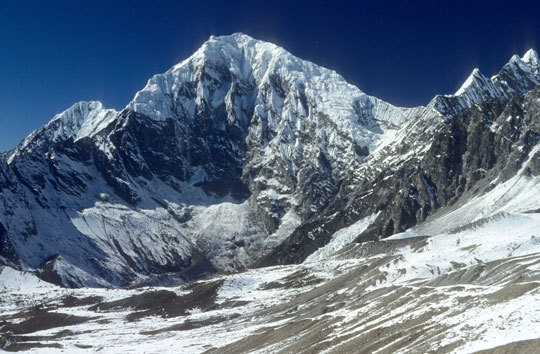
Langtang Lirung (7227m) in the Langtang Himal, close to the border with Tibet, is one of the many 7000-meter peaks in Nepal that now will be cheaper for a small group of climbers outside of the spring season. [Photo] Lindsay Griffin
The Nepalese Government has made progressive changes to peak permits, effective from July 16 of this year. Notable, for exploratory mountaineering, is that for the next five years, after which the situation will be re-assessed, no peak fee is required for any mountain situated in mid-west or far west Nepal. Royalty-free climbing was first introduced to this area in 2002 but only to twenty named peaks. As simply reaching these remote mountain regions involves considerable expenditure on transport, and to date relatively few climbers have made the journey, any incentive to reduce the overall cost of an expedition is welcome. The Ministry of Culture, Tourism and Civil Aviation also announced that the Government has decided to cut the royalty by 50 percent for any peak attempted during the autumn (post-monsoon) season, and 75 percent for those booked for the summer and winter seasons. However, during the most popular time of year, the spring (pre-monsoon) season, no change to the royalty structure will take place. In addition, the number of members allowed on a team has increased from twelve to fifteen.
For many years climbers have argued that the system does not encourage small, lightweight expeditions. But it seems the Government has been listening: in 2002 they introduced a sliding scale based on the size of the team, and the recent fee cuts are substantial. For instance, the peak fee for Everest via the Normal Route used to be $70,000 for up to seven members, with additional fees per member thereafter. In 2002 the Government announced a new structure whereby the royalty fee would be $25,000 for one climber, $40,000 for two, $48,000 for three, $56,000 for four, $60,000 for five and $66,000 for six. This structure is maintained, with each additional climber above seven on a team paying a straight $10,000, but in the autumn all these figures are halved, and in the winter season halved again.
Other routes on Everest are less expensive: $15,000 for one person rising to $50,000 for seven, with, again, these figures halved for the autumn. A one-person expedition attempting one of the country’s other 8000-meter peaks during the autumn now can be completely autonomous for $2,500. For peaks from 7501m to 7999m, the equivalent figure is $1,000, while from 7000-7500m it is $750. Peaks between 6501m and 6999m have a sliding scale of $1,000 for one climber to $2,000 for seven climbers in the spring and again 50% and 75% of these figures for autumn and winter. The one exception to this is 6812m Ama Dablam, which being a highly popular objective in the autumn (for, mostly, commercially organized expeditions), sees no reduction for this season and only a 50 percent reduction for the summer and winter. A two-man expedition to a sub-6500m peak in the autumn now will pay only $250.
With this, the Government of Nepal hopes to attract more and much-needed tourism and should be applauded for taking a small but positive step toward encouraging smaller expeditions throughout its mountain ranges.